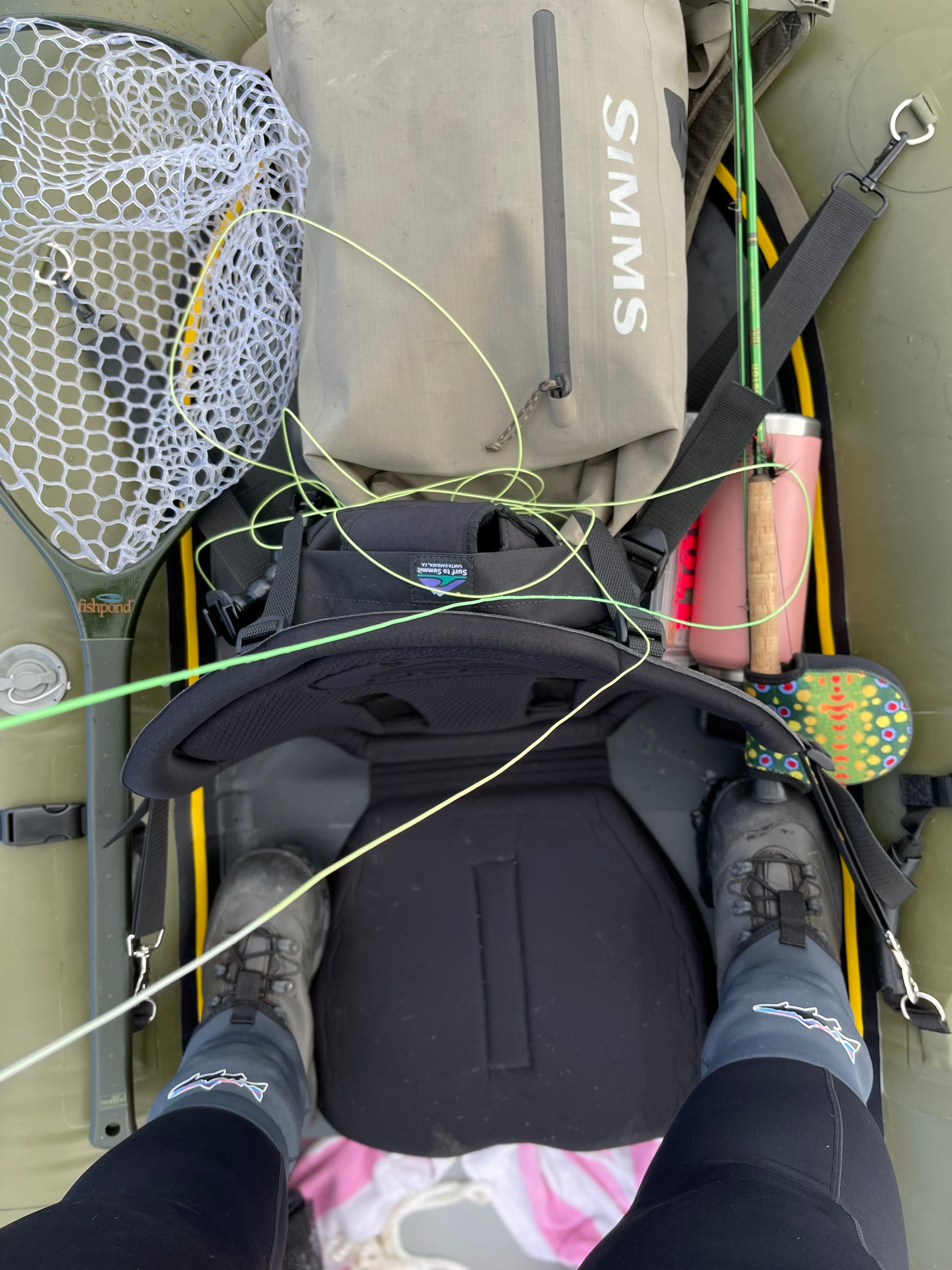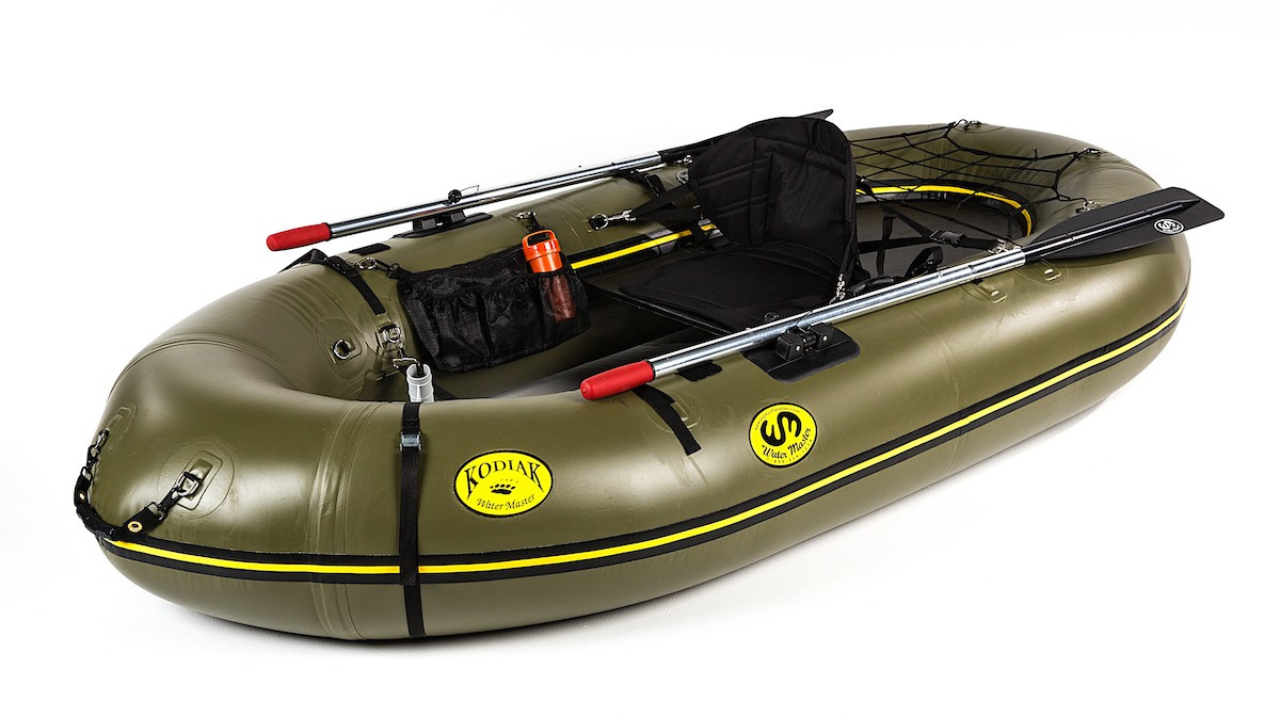
Blog Post
Have Water Master? Will Travel.
with Kat Mulski
Have Water Master? Will Travel...
by Dr. Katherine Mulski
Where it began
I was first introduced to the use of a Water Master Raft three years ago in the the Fall of 2021, on assignment for British Columbia Fishing Tourism Association (FishingBC) when myself and good friend Nicole Gatter were told we would be filming a Fall fishing segment using these rafts to chase trophy rainbow trout on some of British Columbia’s finest interior region lakes.The fishing did not disappoint nor did the ability to transport, inflate, gear up and get out on the water with these versatile rafts. It was a privilege to be able to test one out, see how it would suit my style of fly fishing as well as look at the possibilities of what kind of remote water I could reach with the use of this raft. Once the weekend of filming wrapped up, I knew I needed one of these to start branching out with my own solo fishing endeavors and by Christmas time of the same year, my very own Kodiak Raft made its way from the Water Master Headquarters to my home for unboxing and a whole lot of excitement.
video
Kat's first time on a Water Master
with Fishing BC
Unboxing and Trout Scout Training
I have the privilege of living in close proximity to stillwater that can be fished year-round with many thanks to our Freshwater Fisheries Society of BC. I knew that I wanted to include my trout scout (my faithful angling dog, Nora) in my fishing adventures but knew that I would need to train her first with the raft as well as consider adding the Watermaster boat bottom feature to help keep her safer while floating in the raft. Nora is an English Bulldog but believes to her core that she’s a fly angler, however, what she is not, is a swimmer. I didn’t want to take any chances with her riding on the back of the Kodiak so a boat bottom was ordered a week post-unboxing and the “dry-land” training began.
I inflated my raft with the bottom attached and began positively reinforcing Nora with treats anytime she would sniff the raft, go near it, or put her paws on it. This encouraged her to like the raft immediately as she’s highly driven by snacks and within a day, she was happy to hop into the raft and sit for treats while she got used to her new floating home. The same training was applied for using and wearing her PFD, which helped in spades when we finally made it to the water for our first launch!


Winter Stillwater and Wrestling Rafts
First launch was almost three weeks to the day of unboxing and it so happened that we were gifted with a bluebird January day to get the raft out on the water. As with anything new, the memory of the raft’s material can often be very stiff to begin with and the sub zero starting temperature that day also made for a slower unfolding and inflating. When it came time to pack up for the day, a beachside wrestling match with the raft may or may not have ensued, but I can assure you that it still was easily packed into the backpack that it comes with to help tote it back and forth from my car. I also appreciated the extra warmth the boat bottom gave both my legs and my dog, as the water temps usually dictate how long I will float if I am kicking with my fins and leaving Trout Scout to nap at home.

Portability and Ease of Use
One of the biggest features that had me sold on the use of a Water Master Raft was the ease of portability when transporting the raft from my car to the water’s edge. I primarily use my raft for stillwater use on smaller lakes and hike-in access types of water wherever possible, so the ability to put everything needed to use the raft into a large waterproof backpack is priceless. My packing list usually includes the raft, the oars, the air pump, the seat, extra gear holders as well as the boat bottom, the dog bed, the dog towel, our PFDs, and usually a smaller net. Weight overall is approximately 60 pounds once it’s all in there. Have I been working on my core and squats to ensure I don’t fall over? Absolutely. Can I hike with this setup within short distances especially to lakes where no motorized craft is allowed, giving me access to cover more water than my shoreline associates? Absolutely, and it’s a big reason why I invested in the Kodiak raft. When I’m not hiking in with the raft, the ease of packing things into the backpack for transport in a car is awesome. It’s fairly compact, leaving you room for more gear boxes and coolers for a road trip without sacrificing trunk space.
Water Master has another personal raft, the Grizzly, which is a bit smaller with less cargo space in the back of the raft. However, I wanted to make sure I had enough room for all the things, and knowing I’d be toting a trout scout, more room is best. However, I have tried both models and can say both are sturdy, steer well, and can handle a lot of dragging around, hoisting into trucks, and walking through dense brush and the shrubs that usually give our waders a good run for our money. The Water Waster raft is versatile while also being durable under some of the most unfavorable conditions.

Maintenance and the possibilities to come
That being said, maintenance of the raft is key to keeping it in great shape for years to come. As I am fishing on lakes every month of the year, I will UV coat in the spring in preparation for the intense summer sun as well as regularly wash and dry the boat bottom and the raft prior to any long-term storage as well as to prevent any transference of invasive species into other waters. I am on my third year of fishing with my raft and I have found that using a towel to dry and wipe down the boat bottom and raft prior to folding up for storage, has helped maintain the integrity of the materials and it also helps me keep an eye out for any wear or necessary patching in the future. I have only needed to patch a small amount on my boat bottom as the material is not as thick as the raft itself and can be sensitive to being dragged across sand and rocks so I often set it up using a small tarp whenever possible.
Over the last three years, some of the best memories of fishing with this raft include packing it onto a float plane to fish a remote fly-in lake to chase elusive wild cutthroat trout, to having a ten pound rainbow trout drag it around a little hike-in lake, the fish, finally making it into my net and the raft allowing me the stability to film this bounty fully leaning over into the water to capture some epic underwater footage; to admiring a winter sunrise on the quietest of waters, to setting up amidst ranchlands and cow pies only to find trophy trout that have never been caught by an artificial fly before, to driving across provinces to fish some beautiful Albertan stillwater to chase Tiger trout. I estimate that my watermaster raft has seen well over 100 different lakes over the course of these past three years, and has fished with me, alongside my trout scout, for over 340 days and honestly, I feel like I’ve just cracked the surface of the many possible places I can explore.


If you were ever in doubt as to whether or not a raft of this caliber could enhance your angling possibilities, please remember, I’ve only told you about its use in stillwater. I feel that I need another lifetime, to explore all of the places I could go with its use in rivers and its tributaries. If at all possible, check in with your local fly shop and see if you can rent one of these rafts to see what is the best “fit” for your angling needs. In my case, the Watermaster raft has opened up so many possibilities of the “get up and go” fishing that I was hoping I would be able to do. The bonus of its use is also being able to log as many fishing days with my dog as possible. I cherish these times out on the water and I am thankful for the accessibility to be able to do so.
Get out there, enjoy the water responsibly, leave no trace and remember that the raft will fold up like a dream once the warm weather is upon us!
Tight lines out there!
- Kat

About the Author
Dr. Katherine Mulski wishes to acknowledge that she has had the privilege to live, work, and fly-fish on the traditional, ancestral, and unceded territories of the Coast Salish peoples of the Musqueam (xʷəәθkwəәy̓əәm), Semiahmoo (Semyome), Squamish (Skwxwú7mesh), Stó:lō, and Tseil-Waututh (Səәl̓ílwəәtaɬ) First Nations.
Dr. Mulski is currently the Educator for the Carihi Fly Fishing Program in Campbell River teaching and wrangling teenagers in the ways of the fly rod and conservation. She fly-fishes as many lakes as she can with her Dad, her friends, and her trusty Scout, Nora. You can follow along on her literary and line casting journey on Instagram @kathonthefly


